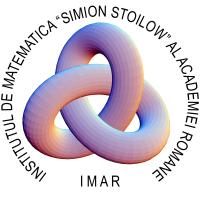
 |
Eleventh Bucharest Number Theory Days |
| Home | Schedule & Abstracts | Local information | Registration |
| Time | July 25th | July 26th |
|---|---|---|
| 9:30-10:20 | Strömberg | Maga |
| 10:20-10:40 | Coffee break | Coffee break |
| 10:40-11:30 | Iorga | Van Order |
| 11:40-12:30 | Papikian | Petridis |
| 12:30-15:10 | Lunch break | Lunch break |
| 15:10-16:00 | Entin | Open discussions |
Fredrik Strömberg,
Hilbert modular groups and Hilbert-Maass forms
We present some theoretical and computational aspects of Hilbert-Maass forms, that is non-holomorphic modular forms on Hilbert modular groups. In particular we will present a recent reduction algorithm for general Hilbert modular groups and how it can be used to extend the ``automorphy'' (aka Hejhal's) algorithm to the setting of Hilbert modular groups.
Andreea Iorga,
Realising certain semi-direct products as Galois groups
In this talk, I will prove that, under a specific assumption, any semi-direct product of a \(p\)-group \(G\) with a group of order prime-to-\(p\) \(\Phi\) can appear as the Galois group of a tower of extensions \(H/F/E\) with the property that \(H\) is the maximal pro-\(p\) extension of \(F\) that is unramified everywhere, and Gal\((H/F) = G\). At the end, I will show that a nice consequence of this is that any local ring admitting a surjection to \(\mathbb{Z}_5\) or \(\mathbb{Z}_7\) with finite kernel can be written as a universal everywhere unramified deformation ring.
Mihran Papikian,
Drinfeld discriminant function and Fourier expansion of harmonic cochains
We study the relationship between the modular units on the Drinfeld symmetric space, the harmonic cochains on the edges of the Bruhat-Tits building of PGL(r), and the cuspidal divisor groups of certain Drinfeld modular varieties of dimension r-1, where r is an arbitrary integer >1. As an application, we obtained a higher dimensional analogue of a result of Ogg about the structure of the cuspidal divisor group of the classical modular curve X_0(p) of prime level. This is joint work with Fu-Tsun Wei.
Alexei Entin,
Sieve methods and the minimal ramification problem in inverse Galois theory
The minimal ramification problem asks for any given finite group \(G\) what is the minimal number \(r(G)\) of primes (including infinity) that ramify in some extension of \(Q\) with Galois group \(G\). In the case of the groups \(S_n\) and
\(A_n\) (symmetric and alternating), a conjecture of Boston and Markin predicts that \(r(S_n)=r(A_n)=1\). While this is still open, progress was made by Bary-Soroker and Schlank who were able to show that \(r(S_n)\le 4\) for all \(n\). This result relies on the Green-Tao-Ziegler theorem on solutions in primes to linear systems of equations.
I will discuss further progress on this problem, showing that \(r(S_n)\le 3\) for all \(n\) and that \(r(A_n)\) is bounded when \(n\) ranges over several arithmetic progressions (e.g. \(n \equiv 0,1 \mod 4\) ). Key ingredients in these results include a modification of the Bary-Soroker - Schlank specialization method, recent results on prime values of homogeneous forms and more classical results on semiprime values of quadratic polynomials. The latter results on the distribution of primes are all based on various sieve methods.
Based on join work with Joachim Konig and Stanley Xiao.
Petér Maga,
On the sup-norm problem of automorphic forms: new counting methods
As it was proved by Sarnak, the supnorm of eigenfunctions of the Laplacian on a compact symmetric Riemannian manifold can be estimated from above by an appropriate power (given in terms of some invariants of the space) of their Laplace eigenvalue. Examples show that Sarnak's exponent is sharp in some cases. However, when the space has also arithmetic symmetries (i.e. Hecke operators) and we restrict to joint eigenfunctions of the Laplacian and the Hecke operators, one might expect a better exponent. Such power-savings are known for arithmetic quotients of several symmetric spaces. In the talk, I will give a brief overview of the history of the problem, and discuss some new matrix counting methods which might potentially yield the desired power-saving in some currently unsettled cases. The talk will be based on ongoing research (joint with Gergely Zábrádi).
Jeanine Van Order,
Central derivative values of Rankin-Selberg L-functions in abelian extensions of real quadratic fields
I will describe some new integral presentations for central derivative values of Rankin-Selberg
L-functions of cuspidal automorphic representations of GL(2) times representations of GL(2) induced by
ring class characters of real quadratic fields (in the spirit of Gross-Zagier) using regularized theta lifts.
These have natural links to links to antecedent work of Popa for central values, ``period'' in the sense
of Kontsevich-Zagier, and the conjecture of Birch and Swinnerton-Dyer, as I will explain. If time permits,
I will also present some open conjectures, as well as fragments of the higher rank/weight setting.
Yiannis Petridis,
Counting and equidistribution
I will discuss how counting orbits in hyperbolic spaces leads to interesting number theoretic problems. The counting problems (and the associated equidistribution) can be studied with various methods, and I will emphasize automorphic form techniques, originating in the work of H. Huber and studied extensively by A. Good. My collaborators in various aspects of this project are Chatzakos, Lekkas, Nordentoft, Risager, and Voskou.